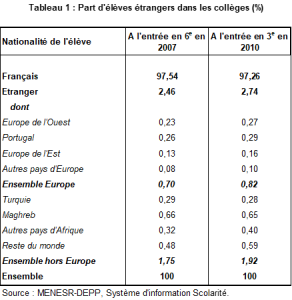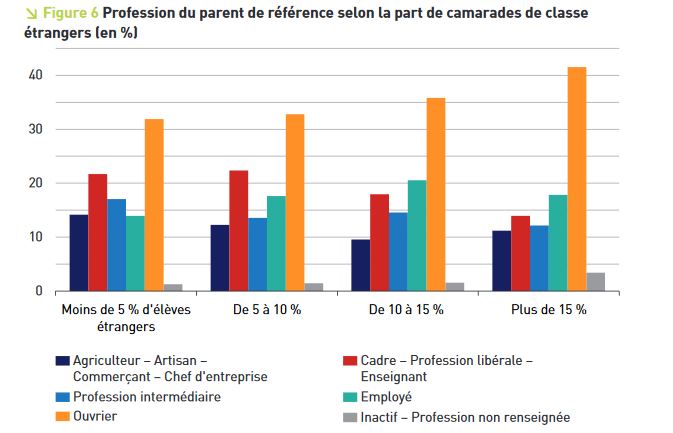


Learning to read: encouraging family reading to reduce inequalities
7 April 2018
Evaluating administrative simplification in higher education and research
8 April 2018Economist Denis Fougère is a CNRS research director at the Center for Studies in Social Change(OSC). He is co-head, with Agnès van Zanten, of the LIEPP’s “educational policies” program. His research focuses on the evaluation of public policies related to the labor market and the educational system. Here he presents research that applies econometric methods to individual data in order to analyze the academic path of a cohort of middle school pupils who started sixth grade in 2007..
The relationship between the concentration of foreign pupils and middle school results: the contribution of panel data
Reflection on ethnic and social diversity in the French school system concerns public authorities, institutions, and parents. A very concrete issue is the possible correlation between educational attainment and the number of foreign children in a middle school class. Denis Fougère offers an answer by using the panel technique. 
The probable effects of the presence of foreign pupils
The presence of foreign pupils in a class could have negative effects on the academic results of their peers for several reasons: teachers might provide them with additional support and adapt the teaching to respond to their specific needs. There might be concerns about a slower pace of teaching or lower expectations. Class cohesion might be affected. Conversely, the presence of foreign pupils might be beneficial to the whole class, given the cultural enrichment it provides.
The balance between these effects notably depends on these pupils integration, which is in turn linked to different factors, including the migratory context and families’ attention to their children’s schooling.
It is also important to note that the general effect of the share of foreign pupils is difficult to identify, since the distribution of foreign pupils in classes is not random. Institutions with high shares of foreign pupils are often in areas where social difficulties are concentrated: poverty, unemployment and lowly skilled adults. Thus the average level of pupils at these schools might be lower than the national average.
A new approach through the measurement of “peer effects”
The deployed methods allow for an assessment of both the effects of pupils’ family and school environment, and a component specific to each student that represents their aptitude throughout their education. 
This type of research is similar to a new approach in the economics of education. It is not just based on the individual paths of pupils, such as their social origin, but also seeks to measure the effects of class composition on academic results. This research identifies what are known as “peer effects”: classes can differ depending on the proportion of pupils of each gender, their different social and ethnic origins and the average academic level of their classmates. Are these differences, which generate more or less diversity within the classes, likely to affect pupils’ results?
The panel: a representative sample of pupils whose education is tracked
The research draws on a panel of secondary school pupils that was developed by the Ministry of Education’s department of evaluation, potential and performance (DEPP). It includes several educational performance measures and information on the national origin and socioeconomic characteristics of pupils and on the number of foreign pupils in middle school classes. It is a particularly rich source of information that allows for a specific answer to the question asked.
The panel was formed on the basis of a national representative sample of pupils who entered sixth grade for the first time in 2007 and were educated at a public or certified private middle school. The pupils in this panel passed standardized tests at the end of sixth grade and of ninth grade. Those who repeated a grade were evaluated again the following year by passing similar tests. It is therefore possible to evaluate their educational progress from sixth grade through ninth grade in both French and mathematics.  This information is enhanced by two other statistical sources. The first one includes surveys conducted in 2008 and 2011 with the pupils’ families. These surveys enabled a collection of information on their socio-demographic characteristics and their relationship to school. Also available was some information about pupils’ academic and social environment: for each institution and class attended, there is data on the share of foreign pupils late pupils and social composition. Finally, the nationality and migratory origins of the pupils or parents are known for each child in the panel. This technique differs from the one that the OECD uses in the PISA survey, which allows for comparisons of educational levels between countries but does not follow student cohorts over several years.
This information is enhanced by two other statistical sources. The first one includes surveys conducted in 2008 and 2011 with the pupils’ families. These surveys enabled a collection of information on their socio-demographic characteristics and their relationship to school. Also available was some information about pupils’ academic and social environment: for each institution and class attended, there is data on the share of foreign pupils late pupils and social composition. Finally, the nationality and migratory origins of the pupils or parents are known for each child in the panel. This technique differs from the one that the OECD uses in the PISA survey, which allows for comparisons of educational levels between countries but does not follow student cohorts over several years.
This information is enhanced by two other statistical sources. The first one includes surveys conducted in 2008 and 2011 with the pupils families. These surveys enabled a collection of information on their socio-demographic characteristics and their relationship to school. Also available was some information about pupils’ academic and social environment: for each institution and class attended, there is data on the share of foreign pupils, late pupils and social composition. Finally, the nationality and migratory origins of the pupils or parents are known for each child in the panel.
Great socioeconomic precariousness
 Upon entry in middle school, foreign and French pupils with two immigrant parents are much more frequently socially and economically underprivileged. Close to one child out of two comes from a working class or blue-collar environment, versus one third for those who have one or no immigrant parent. Less than one out of ten has one or two parents in an executive, teaching, or liberal profession, versus close to a fourth of French pupils with one or no immigrant parent. They are also more frequently exposed to economically precarious situations: 27% live in families with a very low standard of living. Foreign and French pupils with two immigrant parents are much less likely to have mothers with higher education: one out of two has a mother without a degree. 20% have a mother with a degree that is equivalent to or higher than the baccalaureate, versus 50% of French pupils with one or no immigrant parent.
Upon entry in middle school, foreign and French pupils with two immigrant parents are much more frequently socially and economically underprivileged. Close to one child out of two comes from a working class or blue-collar environment, versus one third for those who have one or no immigrant parent. Less than one out of ten has one or two parents in an executive, teaching, or liberal profession, versus close to a fourth of French pupils with one or no immigrant parent. They are also more frequently exposed to economically precarious situations: 27% live in families with a very low standard of living. Foreign and French pupils with two immigrant parents are much less likely to have mothers with higher education: one out of two has a mother without a degree. 20% have a mother with a degree that is equivalent to or higher than the baccalaureate, versus 50% of French pupils with one or no immigrant parent.
In sixth grade, a limited impact
Middle school pupils with a high share of foreign pupils in their class therefore generally come from underprivileged environments and have a lower level of educational attainment upon entering sixth grade. They also score below the national average on exams in mathematics and French held at the end of sixth grade. More specifically, a 10-percentage-point increase in the share of a student’s classmates – that is, two to three extra foreign pupils in a class – is associated with a 3% decrease in average results obtained in mathematics, and a 3.3% decrease in French. 
However, this apparent effect rapidly dissolves when explanatory variables are considered. After taking into account variables in the academic level upon entry in the sixth grade and repetitions in primary school, the parents’ social status, their income level and the class’s social composition, it appears that a 10-point increase in the share of foreign classmates only leads to an average score decrease of 0.5% in mathematics and 0.8% in French at the end of sixth grade. Most of the correlation between the share of foreign pupils in the class and academic performance at the end of sixth grade must therefore be interpreted through the characteristics of the attending pupils, rather than through an effect attributable to the nationality of classmates.
An effect that lessens over time
By the end of ninth grade the share of foreign pupils no longer has a significant effect if one takes into account the student’s level upon entering sixth grade and his/her academic and family environmental, unless one distinguishes between foreign pupils of European and non-European origin. Indeed, a high share of non-European foreign middle school pupils seems to have a slightly negative effect on mathematical scores; a 10-point increase in the share of non-European foreigners is associated with a 0.5% decrease in average results.
Overall, the effect of a higher share of foreign classmates appears to be very modest, and only noticeable at the beginning of middle school.
New research paths
While the deployed method helped answer the question asked and distinguish between a “gross” effect and an adjusted effect by considering complementary explanatory variables, the obtained results confirm the difficulty of establishing causal relationships between two phenomena. This observation points to new research areas.
More information
Denis Fougère, Olivier Monso, Noémie Kiefer et Claudine Pirus, « La concentration des enfants étrangers dans les classes de collèges. Quels effets sur les résultats scolaires ? », Éducation & Formations, n° 95, p. 139-172, décembre 2017
Previous article: Learning to read: encouraging family reading to reduce inequalities <-> Next article: The spatial dimensions of educational inequalities




